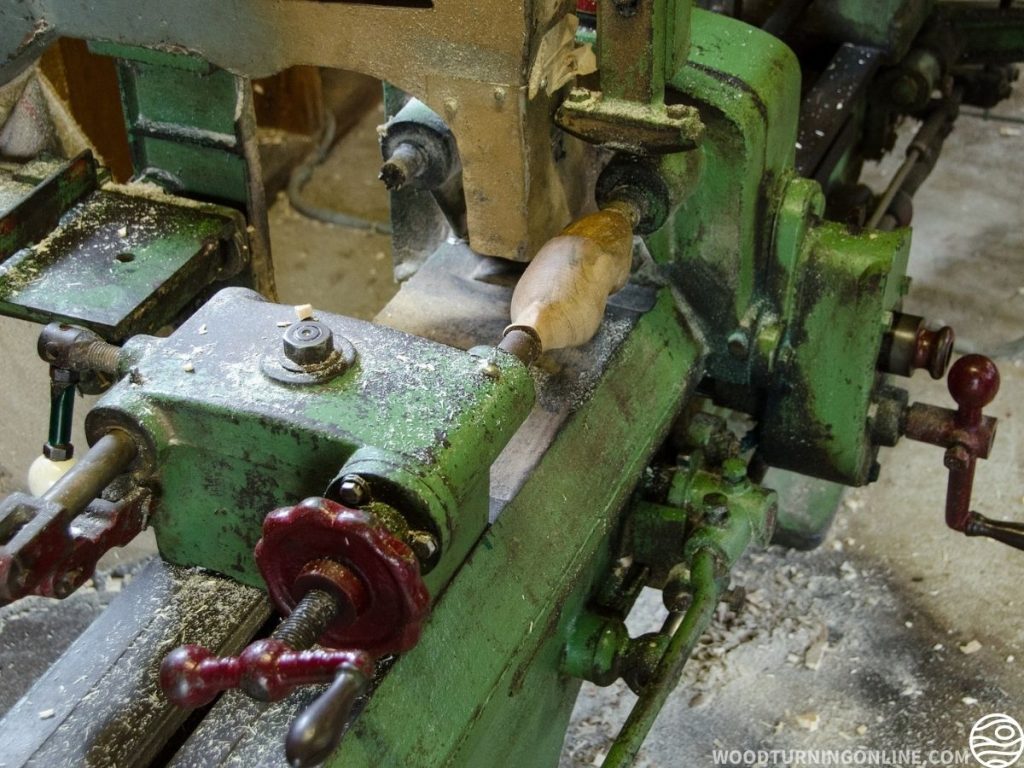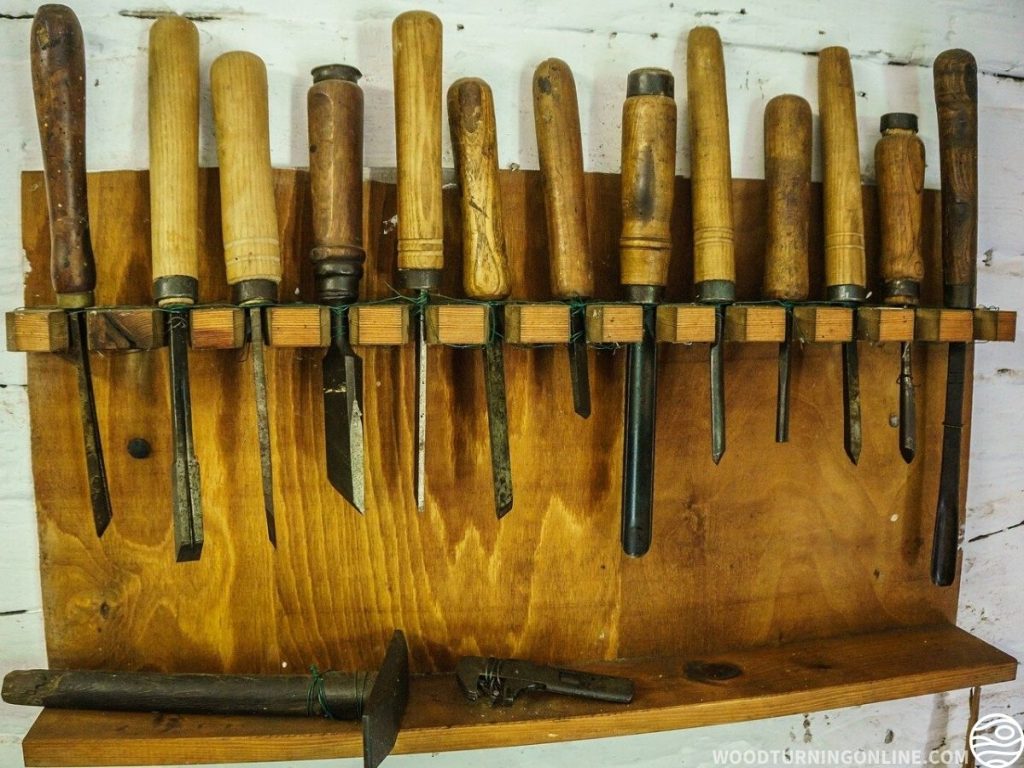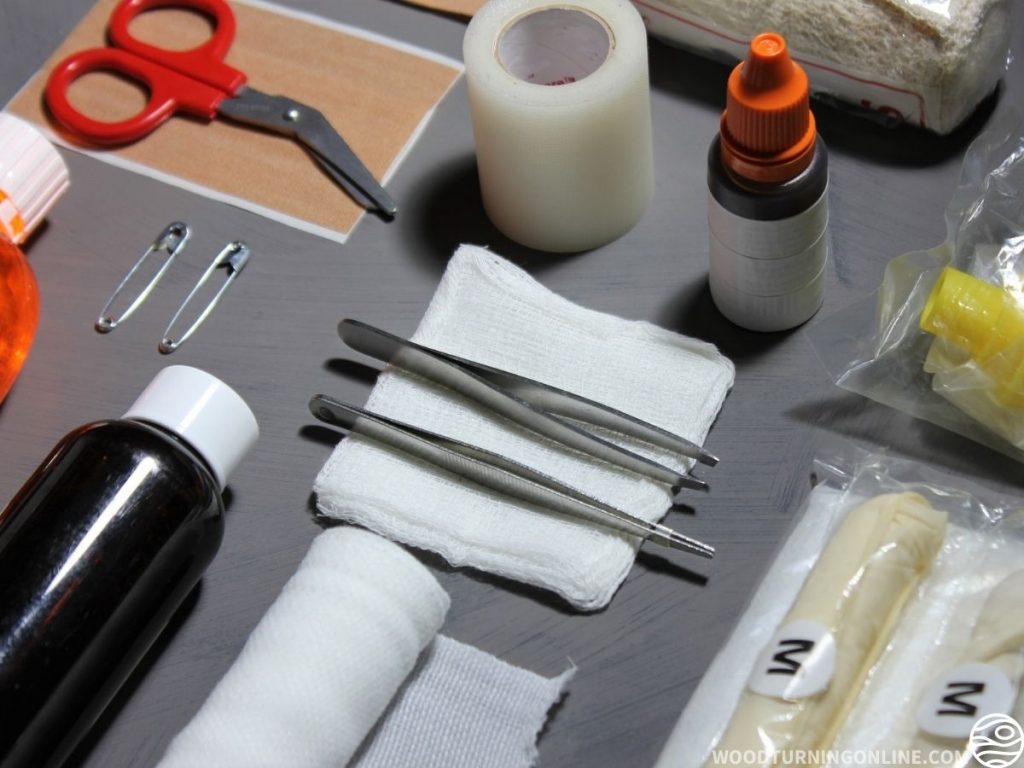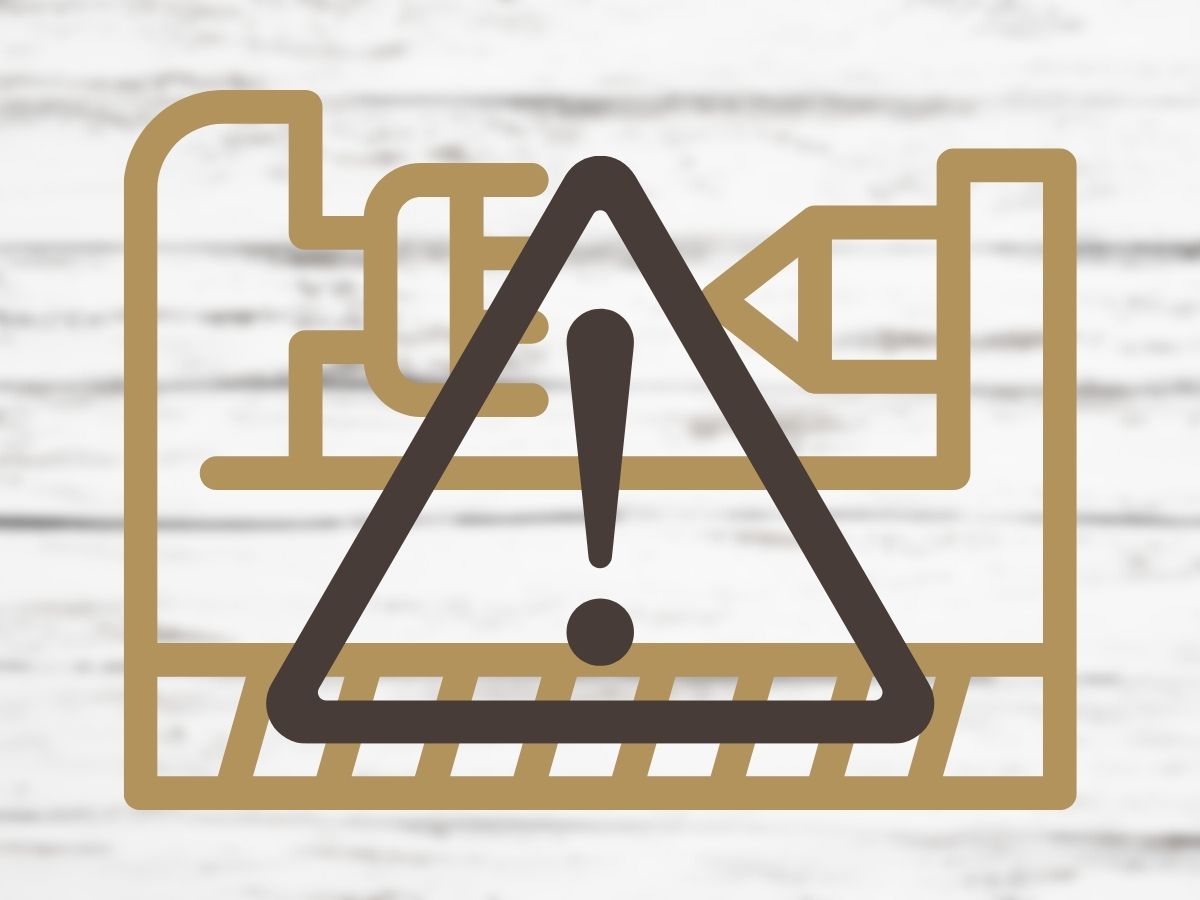In this article, we try to make sure that everyone who reads this site can turn wood as safely as possible. If you don’t know what you’re doing, with all the dust, sharp tools, and heavy, fast-moving machinery, woodturning can get very dangerous. But if you follow my simple advice, you’ll be fine.
Read on to find out what can go wrong, how to avoid that, and the basic safety measures, as well as a turner’s first aid kit.
Table of Contents
- Dangers of Woodturning
- Basic Safety Measures
- #1: Get Trained
- #2: Inspect the Machinery and Tools
- #3: Keep Your Workspace Neat and Tidy
- #4: Use Dust Extractors
- #5: Avoid Ill-Fitting Clothes
- #5: Remove Any Dangling Jewelry
- #6: Wear Protective Gear
- #7: Check the Workpiece and Lathe
- #8: Keep Your Tools within Arm’s Reach
- #9: Check the Lathe Settings
- #10: Keep Your Fingers away from Moving Parts
- #11: Avoid Alcohol and Drugs
- #12: Avoid Distractions
- First-Aid Kit for Turning Emergencies
- Final Words

Dangers of Woodturning
Safety equipment should be your first priority and purchase. If you are willing to skip these then you should seriously consider taking up another hobby (like basket weaving).
In woodturning, the lathes spin at very high speeds—going as high as 4000 rpm. At such speeds, any contact with the machinery can be of high risk. Especially when you start with a fresh piece of wood that is not uniformly shaped, at higher speeds, you will be unable to speed the proper sides, edges, and corners of the workpiece. If you’re not careful, your fingers could get in contact with the spinning wood and get severely damaged.
So, what can go wrong? I’m glad you asked. While woodturning, here are a few common occurrences that can lead to injuries and accidents:
Items Getting Caught in the Lathe
A lathe has a lot of spinning and moving parts. Loose or dangly items could potentially get caught in these and cause a lot of harm. Parts of clothing, fingers, hair, jewelry, or even tools can easily get caught in the lathe’s mechanisms.
Dust Inhalation and Allergies
A lot of people are allergic to certain types of sawdust. For them, exposure to such types of sawdust can lead to rashes. Dust is also harmful if it gets into your eyes, nose, and throat. Prolonged exposure to sawdust can harm the respiratory system. This can cause breathing problems and even lead to lung cancer.
Tools Dropping on Your Feet
As a lathe operates, the entire machinery vibrates at high speed. If there are any loose items left on top of the lathe, these can drop down to the floor. Tools that are left loose can be harmful as their sharp ends can cause serious injuries.
Wood Pieces Flying Towards You
Turning may seem like a relatively safe endeavor (as far as shop tools are concerned) but you are still working with a power tool and dealing with spinning objects that can potentially turn into a ballistic missile or explode into shrapnel in the blink of an eye. This may not happen to you often but it only takes once to receive a serious injury.
As your woodturning tools engage with the workpiece, wood chips are thrown around in the air at high speeds. If your workpiece is soft or has a lot of cracks and splits, the pieces flying off can be much larger.
Basic Safety Measures

Given the above, no matter your level of experience with woodturning, following some basic safety principles will help you keep injuries and accidents at bay. Here are some general safety measures to follow while working a woodturning lathe.
#1: Get Trained
Yes, sorry. It may sound boring but first and foremost I am going to tell you to find yourself proper in-person training. You need to understand the workings of the machinery well before you begin. If you’re an amateur, do not operate the machinery without any supervision. If you want to start a home workshop, attend some classes at any nearby workshop and learn the proper way to use a lathe and related equipment.
#2: Inspect the Machinery and Tools
Before you begin woodturning, inspect your workspace, machinery, and tools. Check that there are no exposed wires, frayed cords, short circuits, or other such issues. Also, ensure that the turning tools are sharp and well maintained.
#3: Keep Your Workspace Neat and Tidy
Try to keep your workspace as clean as possible. Keeping your workspace clean entails keeping your tools in their designated place. Having to search for your tools while the lathe is on is dangerous and any kind of disturbance during that time can lead to accidents.
#4: Use Dust Extractors
Dust tends to accumulate, so periodic cleaning is crucial to avoid accidents. To prevent any dust-related problems, proper dust extraction is essential. Use dust extractors often to reduce the accumulation of dust.
This not only keeps your workspace clean but also prevents any breathing and lung issues. Also, keep the lathe free of dust before use so that this dust doesn’t interfere with the lathe’s mechanisms.
#5: Avoid Ill-Fitting Clothes
While woodturning, there is a lot of spinning machinery and sharp tools. To avoid getting your clothes and sleeves stuck in anything, wear fitted clothes that don’t hinder your work. If you have long hair, tie it up to avoid getting it caught in the lathe.
#5: Remove Any Dangling Jewelry
Dangling necklaces and bracelets can also get caught in the lathe, so avoid wearing them. Also, avoid precious jewelry in general as you might not want to drop them while working and lose them.
#6: Wear Protective Gear
To protect your body from all the dust, wood chips, and splinters, use protective gear. In the next section, you will find the different types of items that can be a part of your protective gear while woodturning.
#7: Check the Workpiece and Lathe
Before turning on the lathe, secure the workpiece safely such that there is no chance for it to spin out. Also, check the workpiece to see that there are no cracks or splits that could lead to the workpiece breaking during the woodturning process.
Check all the parts of the lathe to see if everything is tightly fastened. See to it that no tools are lying on the lathe as they can drop off or interfere with your work when the lathe is switched on.
#8: Keep Your Tools within Arm’s Reach
Before switching the lathe on, collect all the tools you need for the current project and keep them in the tool rest. Fix the tool rest to the lathe such that you can reach it easily while operating the machine.
#9: Check the Lathe Settings
Before you turn on the lathe, check the speed and direction that it is set to. With every fresh piece of wood, start at the lowest speed that you will instantly know if it is not mounted properly.
#10: Keep Your Fingers away from Moving Parts
While woodturning, your hands are constantly engaged with the tools. Make a conscious effort to keep your fingers away from any moving parts of the lathe or workpiece. This is most crucial while working on non-uniform workpieces.
#11: Avoid Alcohol and Drugs
Intoxicating substances like drugs and alcohol can influence your judgment and play with your senses. Sobriety while operating power tools is an important rule to go by.
#12: Avoid Distractions
While woodturning, your complete focus should be on the task at hand. Any distractions can deter your attention, which can not only ruin your workpiece but can also lead to accidents.
Click here for our tips on safety equipment for woodturning.
First-Aid Kit for Turning Emergencies

No matter how prepared you are and how safely you do everything, accidents can happen. So, it is wise to always have a first-aid kit in your workshop for such emergencies. Here are a few items that you must include in your first-aid kit:
#1: Sterile Saline Solution
One of the most common hazards that can happen in a woodturning workshop is that you can get the sawdust in your eye. If not dealt with instantly, this can cause serious damage to your eye.
Have a dedicated eyewash station equipped with a sterile saline solution in your workshop. The solution can flush out all the dust and debris safely without causing any harm.
#2: Antibiotic Ointment
In case of any cuts or wounds, it is necessary to clean them well before covering them. While most wounds can be easily washed with water, some larger or deeper cuts can be difficult to wash. Keep some antibiotic ointment in your first aid kit specifically for this purpose.
#3: Band-Aids/Adhesive Bandages
Small cuts and nicks can easily be covered with adhesive bandages. These are available in most stores and come in different shapes and sizes. Stock up on a variety of adhesive bandages to tend to any small cuts.
#4: Steri-Strips/Butterfly Strips
For longer cuts, it is important to keep the wound gash closed, such that external dust and debris don’t enter into the wound. You can use butterfly strips to keep wounds closed.
#5: Gauze Pads and Gauze Tape
For larger wounds, bandages might not be large enough to close the wound completely. For such cases, gauze pads come in handy. You can use gauze pads to cover the wound and gauze tape to hold the pads in place.
#6: CA Glue
Cyanoacrylate adhesive, commonly known as CA glue, can be used to stitch smaller cuts yourself. In case of minor, shallow cuts like paper cuts or knife cuts, you can apply CA glue to both edges of the cut and gently bring them together to close the wound.
#7: Tweezers
Tweezers are also very essential in a first aid kit. If you get splinters or other debris stuck in your wound, it is necessary to remove them before closing the wound. Keep sterile tweezers to dig out these splitters safely and easily.
#8: Magnifying Glass/Headset
With a magnifying glass or a headset with built-in magnifiers, you will be able to locate and remove small splinters easily. This helps you clean the wounds well before covering them. Splinters that get left inside the wound can infect the wound, causing larger problems.
#9: Tourniquet
For major cuts and wounds, the first thing to do is to reduce bleeding by limiting the flow of blood to the affected area. With a tourniquet, you can easily apply pressure near the wound to regulate the blood flow.
#10: Cold Pack + Zip Lock Bag
In the case of major accidents, where there is an amputation, the amputated part needs to be preserved for surgery. Keep a zip-lock bag to store the amputated part and a cold pack that can keep the bag cool.
Final Words
While woodturning can be dangerous, the safety measures I’ve listed above can surely help you avoid a lot of accidents. Whether you’re an amateur or an expert, it’s always best to follow these guidelines during every woodturning session. Turn safe!
